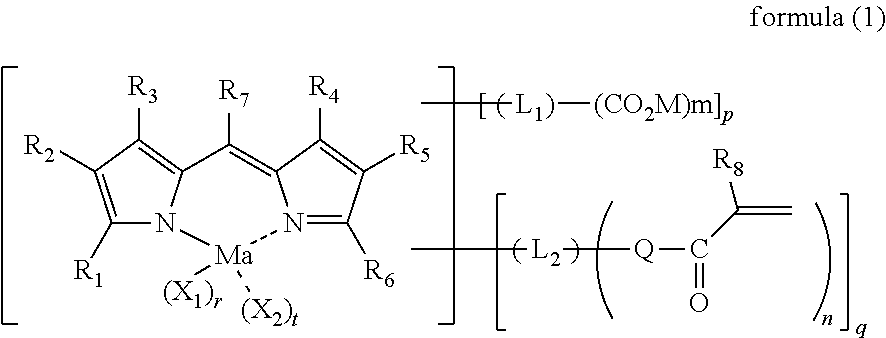Colored curable composition, resist liquid, ink for inkjet printing, color filter, method of producing color filter, solid-state image sensor, liquid crystal display, organic el display, image display device and colorant compound
a color curable composition and resist liquid technology, applied in the field of color curable compositions, can solve the problems of difficult adjustment of the solubility (developability) of the cured portion and the uncured portion, difficult to further improve the fineness in view of color irregularities, and difficult to achieve the effect of reducing the number of colors
- Summary
- Abstract
- Description
- Claims
- Application Information
AI Technical Summary
Benefits of technology
Problems solved by technology
Method used
Image
Examples
example 1-1
[0309]Exemplary compound a-5 was synthesized in accordance with the following synthesis scheme.
[0310](Synthesis Scheme of Exemplary Compound a-5)
[0311]
[0312]4.11 g of 2-aminopyrrole compound A in acetonitrile were stirred at room temperature, and 1.33 g of 2-chloropropionyl chloride were dropped therein and stirred for 30 minutes at room temperature. A precipitated crystal was separated by filtering and washed with 5 ml of acetonitrile, thereby obtaining Compound 1 (2.22 g).
[0313]Compound 1: 1H-NMR, 400 MHz, δ(CDCl3)ppm: 0.45-1.58 (28H, m), 1.83-1.85 (3H, d), 4.57-4.6 (1H, q), 5.89 (1H, s), 6.35 (1H, s), 7.28-7.38 (5H, m), 10.78-10.82 (1H, br), 11.47-11.51 (1H, br).
[0314]
[0315]Compound 1 (5 g) and 1.2 g of 3-mercapto-1-propanol were dissolved in 15 ml of dimethyl acetamide and stirred at room temperature. 1.82 g of DBU (1,8-diazabicyclo[5.4.0]undec-7-ene were dropped therein and stirred for 1 hour at room temperature. This reaction solution was poured in 200 ml of aqueous hydrochlor...
example 1-2
[0334]Exemplary Compound d-2 was synthesized in accordance with the following synthesis scheme and formulation.
[0335]
[0336]206.4 g of isopropyl methyl ketone in 1 L of methanol were stirred, and 7 ml of hydrobromic acid (47-49% aqueous solution) were added. Thereafter, bromine was dropped therein over 3 hours at 30-34° C. This was then stirred for 30 minutes at 30° C. After neutralizing with an aqueous solution prepared by dissolving 124 g of sodium hydrogen carbonate in 1.3 L of water, an aqueous solution prepared by dissolving 400 g of sodium chloride in 1.3 L of water was added, and a phase-separated reaction product in the form of a liquid was collected.
[0337]Separately, 222 g of phthalimide potassium salt in 800 ml of dimethyl acetamide (DMAc) were stirred and the reaction product obtained in the above process was dropped therein while cooling with water, and stirred for 4 hours at room temperature. Thereafter, 720 ml of water were added while cooling with water, and the precip...
example 1-3
[0371]Exemplary Compounds e-1 to e-14 can be obtained by synthesizing 2,6-di-tert-butyl-4-alkylcyclohexanols as an intermediate. 2,6-di-tert-butyl-4-alkylcyclohexanols can be synthesized in accordance with a method in which 2,6-di-tert-butylcyclohexanones are obtained by adding hydrogen to 2,6-di-tert-butyl phenols, and reducing the same with lithium aluminum hydride, as described in Journal of American Chemistry, Vol. 179, pp. 5019-5023 (1957). Alternatively, 2,6-di-tert-butylcyclohexanols can be synthesized by a method in which 2,6-di-tert-butylcylohexanones are reduced with sodium boron hydride under the presence of magnesium chloride or aluminum chloride, using diglyme as a reaction solvent, as described in Japanese Patent No. 4,065,576.
[0372]Among these, Exemplary Compound e-9 was synthesized in accordance with the following synthesis scheme and formulation.
[0373]
[0374]73.6 g of 2,6-di-tert-butyl-4-(hydroxymethyl)phenol, 12.5 g of Raney nickel and 340 ml of tert-butyl alcohol w...
PUM
| Property | Measurement | Unit |
|---|---|---|
| vapor pressure | aaaaa | aaaaa |
| boiling point | aaaaa | aaaaa |
| thickness | aaaaa | aaaaa |
Abstract
Description
Claims
Application Information
 Login to View More
Login to View More - R&D
- Intellectual Property
- Life Sciences
- Materials
- Tech Scout
- Unparalleled Data Quality
- Higher Quality Content
- 60% Fewer Hallucinations
Browse by: Latest US Patents, China's latest patents, Technical Efficacy Thesaurus, Application Domain, Technology Topic, Popular Technical Reports.
© 2025 PatSnap. All rights reserved.Legal|Privacy policy|Modern Slavery Act Transparency Statement|Sitemap|About US| Contact US: help@patsnap.com



